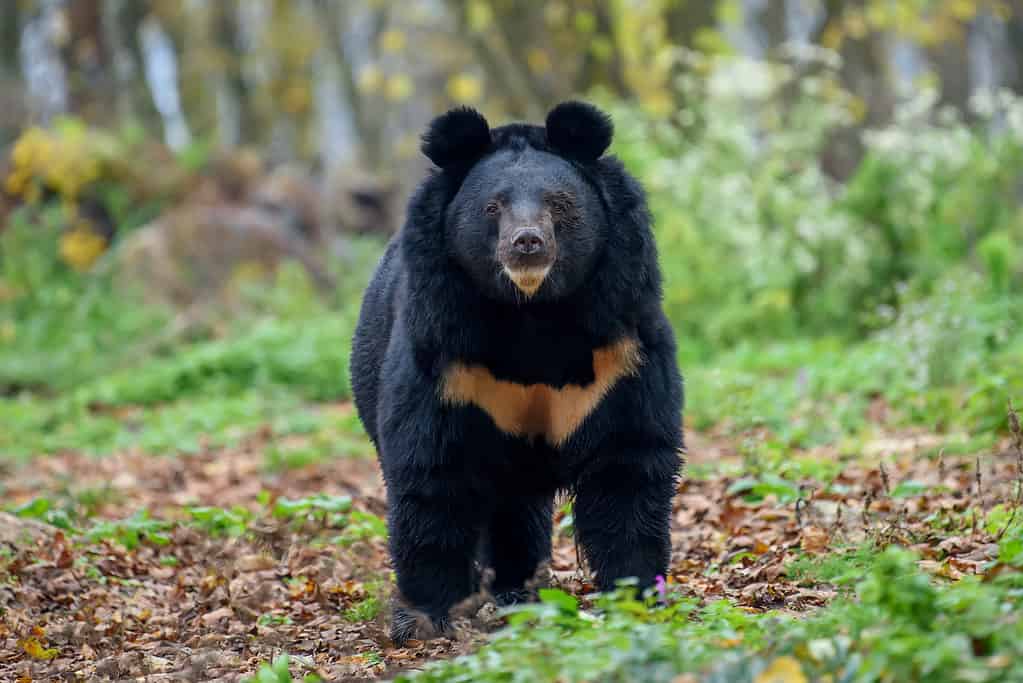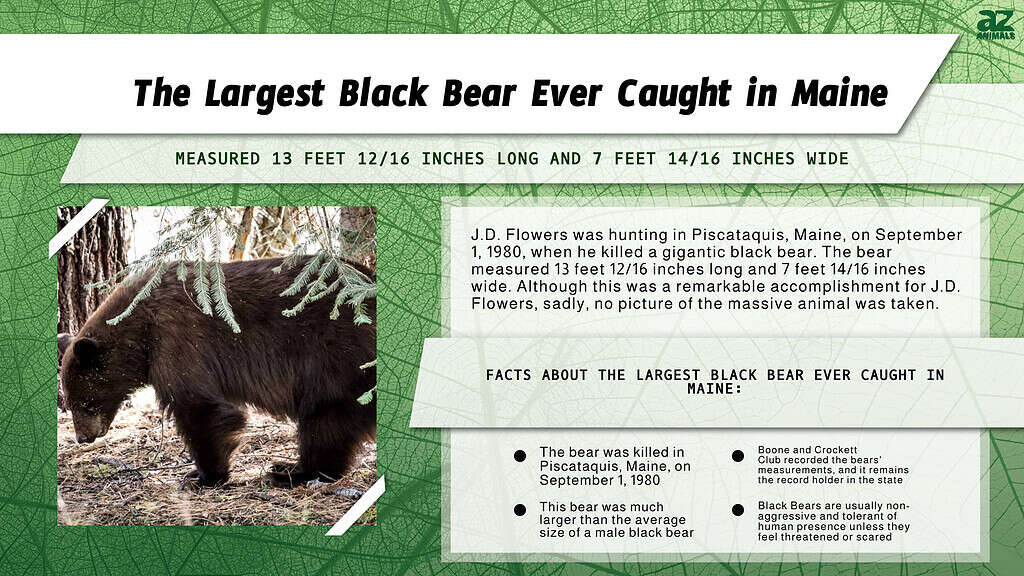Bear Hunting Season in Maine
Maine’s bear hunting season begins in August and extends through November. Spot and stalk and still-hunting are allowed throughout the season, but other methods are limited. Hunting over bait is allowed for the first four weeks. Hunting with dogs lasts six weeks, starting with the season’s third week. Trapping is open from September 1 through October 31. With that information in mind, let’s discover the largest black bear ever caught in Maine!
Where to Hunt?
There are a lot of bears in Maine, and you can hunt and trap them legally throughout the state. However, much of the forestland in Maine is privately owned, so you’ll need to get permission from the landowners. Hunters legally need permission from landowners in many situations, such as when placing bait or setting up a game camera. It’s always best to secure written permission before doing anything related to bear hunting on private property.
If you’re in search of an exciting hunting adventure, look to Aroostook County, Maine. This area is home to some of the largest black bears, moose, ruffed grouse, and whitetail deer on the continent. With its mix of hardwood forests, rolling hills, and wetlands, you will be surrounded by natural beauty.
Guided Bear Hunts

You can choose between a fully guided or partially guided hunt, depending on your comfort level and experience hunting black bears.
©Volodymyr Burdiak/Shutterstock.com
Many hunters in Maine choose to go with a guide. You can choose between a fully guided or partially guided hunt, depending on your comfort level and experience hunting black bears. It’s important to plan your hunt before November 1, when most bears enter their winter dens. Bears are active during this time and more likely to be spotted. Not only is this an exciting way to get up close with wild animals, but you’ll have the chance to bag one of the biggest black bears!
Biggest Bear Ever Caught in Maine
J.D. Flowers was hunting in Piscataquis, Maine, on September 1, 1980, when he killed a gigantic black bear. The bear measured 13 feet 12/16 inches long and 7 feet 14/16 inches wide. Although this was a remarkable accomplishment for J.D. Flowers, sadly, no picture of the massive animal was taken.
Boone and Crockett Club recorded the bears’ measurements, and it remains the record holder in the state.

Is It Normal for Black Bears to Get This Big?
It is not unheard of for black bears to grow very large. However, the largest black bear ever caught in Maine was much larger than the average size of a male black bear. They typically weigh between 250-600 pounds and measure 5-6 feet in length. Female black bears tend to weigh about 25% less than males and measure around 3-5 feet long.
It is still quite impressive that a Maine black bear could reach such an immense size! The factors contributing to this large size include genetics, habitat availability, food sources, age, and sex. If plenty of nutrient-rich foods are available within its home range, like berries or nuts, then it can gain weight fast. Furthermore, older bears have more time to bulk up compared to younger ones, so they will likely be bigger overall.
Natural Habitat
The largest black bear ever caught in Maine was discovered in its natural habitat. Black bears require forests for protection and food and are able to adapt to human presence. Maine has 26,660 square miles of habitat, consisting of mostly second-growth conifer-deciduous forest. This environment provides an ample supply of bear foods.
Dens
You can find black bear dens in the dense woods and forests of Maine. These dens are typically located on north-facing slopes that protect them from strong winds and winter snows. They may also be made in hollow trees or logs, rock crevices, brush piles, or even abandoned buildings.
Bears tend to return to the same den year after year unless disturbed by humans or predators. To find homes for their young cubs during the winter months, some female black bears will dig out den sites beneath large fallen logs or tree roots near rivers and streams. These ‘dens’ protect them from extreme temperatures, as well as provide shelter from predators. Not all Maine bears hibernate – some might remain active throughout the cold season if they have adequate food sources nearby!
Eating Habits
Bears have opportunistic eating habits, meaning they eat a variety of both vegetation and animal matter. Their diet is largely vegetarian, consisting of grasses and clover in the spring and fruits and berries during the summer. They eat beechnuts, acorns, and hazelnuts in the fall. In addition to these plant-based foods, bears also feed on insects such as ants and bees (both larvae and adults). They may even eat occasional small mammals or birds.
Although they are not efficient predators, bears will hunt young deer or moose in spring if food is scarce. Bears have been observed adapting rapidly to new food sources that may be dangerous for them, such as agricultural crops. This also includes human-provided food sources like bird feeders or garbage cans with easy access.
This interaction between bears and human areas can lead to conflicts. Rural residents (especially farmers or beekeepers) may see their crops damaged by hungry bears looking for an easy meal. To prevent this from happening, it’s best practice to take all necessary precautions when living near wildlife habitats. This will minimize any potential conflicts with wild animals like black bears.
The fall season is especially important for pregnant female black bears. During this period, they must feed intensively to build up enough fat stores to sustain them through the winter. The approaching cold months make it more difficult for them to find food.
Reproduction

In January and February, female bears give birth to between one to four cubs.
©Geoffrey Kuchera/Shutterstock.com
Black bears mate from May to August, with most breeding activity taking place in June and July. Although black bears breed during the summer, fetal development doesn’t start until early winter, after the female has entered a den. In January and February, female bears give birth to between one to four cubs.
Cubs weigh about 12 ounces at birth and stay with their mother for 16-18 months. After that, they enter dens with their mother in the fall.
Females usually reproduce every other year, but this can vary depending on the availability of food (especially beechnuts). In recent years, cub production has been more consistent in central Maine, where there is a larger supply of beechnuts.
Lifespan
Bears can live for up to 30 years in the wild. However, many don’t make it to their first birthday, with starvation being a major cause of death. Those that make it to two years old have a much higher survival rate. Sadly, adult bears usually die due to hunting or other human-related causes.
Threats and Conservation
The American black bear is not at risk of extinction, although some sub-species are endangered. The overall population of black bears has increased in North America over the last few decades. In fact, it’s estimated that there are now around 400,000 black bears in the US alone.
Black Bears are usually non-aggressive and tolerant of human presence unless they feel threatened or scared. When this happens, it is typically due to hunting or destruction of their habitats, such as deforestation for agriculture or urban development.
To protect these species, conservationists suggest reducing hunts and creating protected areas for bears to live away from human activity. Additionally, increased public awareness about coexisting peacefully with wild animals is important, to ensure both the safety of humans and black bears alike.
Where is Piscataquis, Maine Located on a Map?
Belonging to the second-largest county in Maine, Piscataquis is located in the geographical center of the state, on the banks of the Piscataquis River. It is close to Interstate 95 and the Penobscot off-reservation trust land to the east and Route 6 to the west and south.
The photo featured at the top of this post is © SCStock/Shutterstock.com
Sources
- boone-crockett.org / Accessed January 2, 2023
- boone-crockett.org / Accessed January 2, 2023
- maine.gov / Accessed January 2, 2023
- maine.gov / Accessed January 2, 2023
Thank you for reading! Have some feedback for us? Contact the AZ Animals editorial team.







